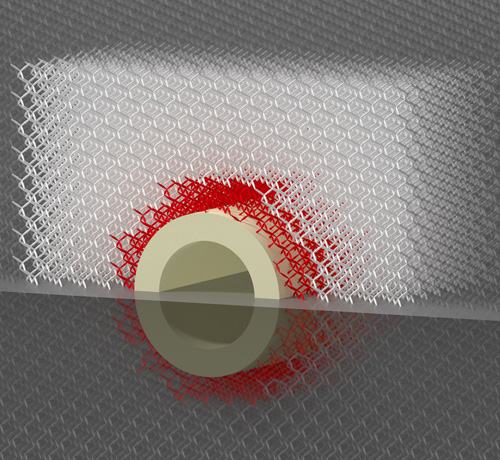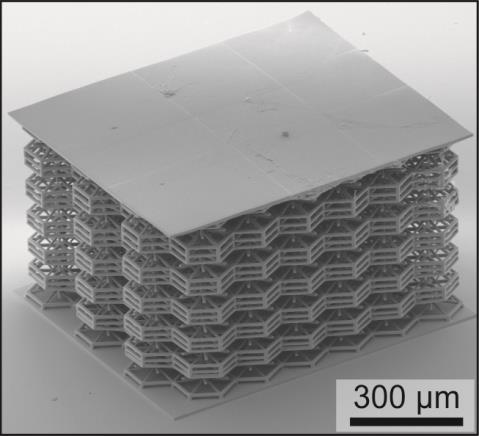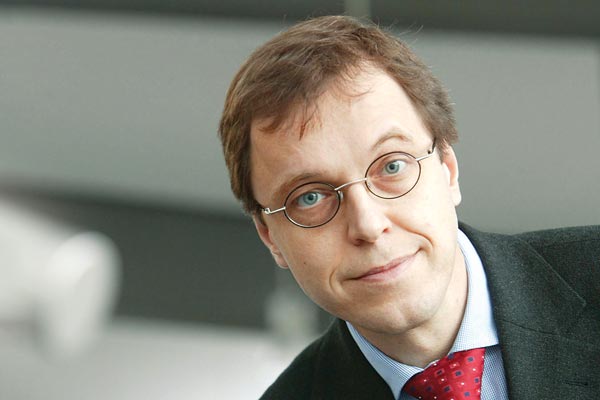Mechanische Metamaterialien
Dr. Claudio Findeisen – Hector Fellow Peter Gumbsch
Dr. Muamer Kadic – Hector Fellow Martin Wegener
Im Gegensatz zu klassischen Materialien hängen die Eigenschaften von Metamaterialien von deren spezieller Mikrostruktur ab. Neue Herstellungsverfahren erlauben die Erzeugung von 3D-Metamaterialien mit Mikrostrukturen auf der Mikrometer-Ebene. In diesem Projekt ging es darum, das Design von neuen mechanischen Metamaterialien zu erforschen.
Beteiligt waren die Hector Fellows Peter Gumbsch und Martin Wegener gemeinsam mit dem HFA Postdoktoranden Dr. Muamer Kadic (Karlsruher Institut für Technologie, Institut für Angewandte Physik) und dem HFA Doktorand Claudio Findeisen (Karlsruher Institut für Technologie, Institut für Angewandte Materialien).
In contrast to classic materials, the properties of metamaterials result from their specific microstructure rather than their atomistic properties. New production methods, such as direct laser writing, allow for the production of such 3D metamaterials with microstructures in the range of micrometers, which is impossible with standard fabrication methods. In this collaboration project, the young scientists investigate the design of new classes of metamaterials. They present two classes of materials to protect from linear vibrations using cloaking devices and to absorb energy via inner instabilities of micro-lattices.
An elasto-mechanical “unfeelability” cloak made of pentamode metamaterials
Metamaterial-based cloaks make objects that differ from their surroundings appear just like their surroundings. To date, cloaking has been demonstrated experimentally in many fields of research. However, cloaking in the apparently simple case of three-dimensional solid mechanics is more demanding.
Inspired by invisible core-shell nanoparticles in optics, the scientists design an approximate elasto-mechanical core-shell “unfeelability” cloak based on pentamode metamaterials (see Figure 1). The resulting three-dimensional polymer microstructures with macroscopic overall volume are fabricated by rapid dip-in direct laser writing optical lithography. The researchers perform quasi-static experiments and map the displacement fields by autocorrelation-based analysis of recorded movies.

Figure 1: An elasto-mechanical unfeelability cloak made of pentamode
Tailored buckling micro-lattices as reusable light-weight shock absorbers
Structures and materials absorbing mechanical (shock) energy commonly exploit either viscoelasticity or destructive modifications. Based on a class of uniaxial light-weight geometrically nonlinear mechanical micro-lattices and using buckling of inner elements, they achieve either a sequence of snap-ins followed by irreversible hysteretic – yet repeatable – self recovery or, alternatively, multi-stability enabling programmable behavior. Proof-of-principle experiments on three-dimensional polymer micro-structures are done (see Figure 2).

Figure 2: A shock absorber using tailored buckling micro-lattices
Dr. Claudio Findeisen
DoktorandDr. Muamer Kadic
PostdoktorandPublikationen aus dem Projekt
- Kern C., Schuster V., Kadic M., and Wegener M., Phys. Rev. Appl., DOI: 10.1103/PhysRevApplied.7.044001 (2017).
- Qu J., Kadic M., Naber A., and Wegener M., Scientific Reports, DOI: 10.1038/srep40643 (2017).
- Findeisen C., Hohe J., Kadic M., and Gumbsch P., J Mech Phys Solids, DOI: 10.1016/j.jmps.2017.02.011 (2017).
- Kern C., Kadic M., and Wegener M., Phys. Rev. Lett., DOI: 10.1103/PhysRevLett.118.016601 (2017).
- Frenzel T., Findeisen C., Kadic M., Gumbsch P., Wegener M., Adv. Mater., DOI: 10.1002/adma.201600610 (2016).
- Schittny R., Niemeyer A., Mayer F., Naber A., Kadic M., and Wegener M., Laser Photonics Rev., DOI:10.1002/lpor.201500284 (2016).
- Kadic M., Bückmann T., Schittny R., and Wegener M., Phil. Trans. R. Soc. A, DOI: 10.1098/rsta.2014.0357 (2015).
- Kadic M., Schittny R., Bückmann T., Kern C., and Wegener M., Phys. Rev. X, DOI: 10.1103/PhysRevX.5.021030 (2015).
- Bückmann T., Kadic M., Schittny R., and Wegener M., PNAS, DOI: 10.1073/pnas.1501240112 (2015).
- Schittny R., Niemeyer A., Kadic M., Bückmann T., Naber A. and Wegener M., Optica, DOI: 10.1364/OPTICA.2.000084 (2015).
- Bückmann T., Kadic M., Schittny R., and Wegener M., Phys. Status Solidi B, DOI: 10.1002/pssb.201451698 (2015).
- Schittny R., Niemeyer A., Kadic M., Bückmann T., Naber A. and Wegener M., Optics Letters, DOI: 10.1364/OL.40.004202 (2015).
- Kern C., Kadic M., and Wegener M., Appl. Phys. Lett., DOI: 10.1063/1.4932046 (2015).
- Christensen J., Kadic M., Kraft O. and Wegener M., MRS Communications, DOI: 10.1557/mrc.2015.51 (2015).
- Kadic M., Bückmann T., Schittny R., Gumbsch P., and Wegener M., Phys. Rev. Applied, DOI: 10.1103/PhysRevApplied.2.054007 (2014).
- Bückmann T., Thiel M., Kadic M., Schittny R., and Wegener M., Nat. Commun., DOI: 10.1038/ncomms5130 (2014).
- Schittny R., Kadic M., Bückmann T. and Wegener M., Science, DOI: 10.1126/science.1254524 (2014).
Betreut durch

Karl Leo
PhysikHector Fellow seit 2013

Manfred Kappes
Chemie & PhysikHector Fellow seit 2009

Martin Wegener
Physik & Ingenieurwesen

Eberhart Zrenner
Medizin, Biologie & Ingenieurwesen


